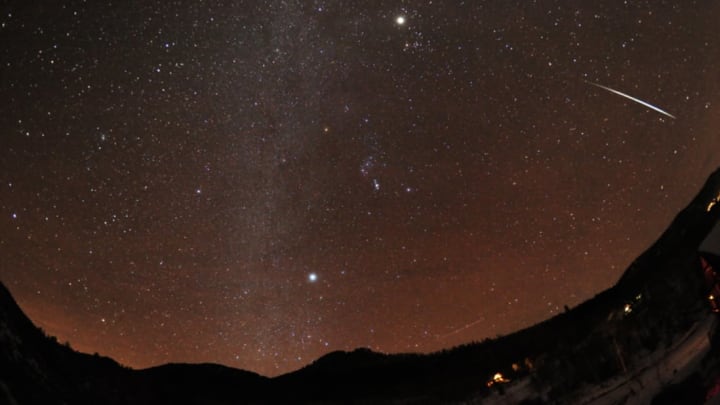Look Up! The Geminid Meteor Shower Is Here

On Sunday December 13 and Monday December 14, the Geminid meteor shower rounds out 2015's offering of celestial wonders. According to Sky & Telescope, if you have clear, dark skies, you may be able to see a shooting star every minute or two from 10 p.m. local time until dawn on those two peak nights. The meteors are slower moving than you might expect, and the Moon will be but a sliver, creating ideal conditions. It's the final big meteor shower of 2015, and should be one of the best. (And we've had some great meteor showers this year.)
"Shooting stars" are debris from space burning up as they speed into our atmosphere. Because meteor showers (lots of shooting stars) generally originate from comets, the Geminid shower's a weird one: Its source is an asteroid.
WHAT'S GOING ON?
Asteroid 3200 Phaethon, the shower's source, has an orbit that takes it close to the Sun. Really close. Its perihelion (the closest it gets to the Sun during its orbit) is about half that of Mercury. As you might imagine, this makes its surface really hot, and causes cracks and the ejection of particles, or thermal disintegration. Solar radiation pushes the particles away from the nucleus of Phaethon, forming a comet-like tail. Because of all this, it is sometimes called a "rock comet." This annual debris ejection at perihelion alone isn't directly causing the Geminid meteor shower. Rather, over time, Phaethon's particles are spread along its orbit. What you are seeing in the Geminid shower is the place where the orbit of the Earth and the debris-laden orbit of Phaethon meet, and particles slamming into our atmosphere at tens of thousands of miles per hour.
The asteroid was only discovered in 1983 by NASA's IRAS satellite, and there's an awful lot about it that scientists haven't yet worked out. Phaethon is named for the son of Helios, the sun god in Greek mythology. As for the meteor shower, it is named for the constellation Gemini, from which it seems to emerge. Sunday night, however, don't limit yourself to staring at Gemini—for most of us non-astronomers, the meteors will seem to be all over the place. Get away from light pollution and give your eyes a half-hour to adjust, and you'll be well prepared.
BAD WEATHER? NO PROBLEM.
The Geminids aren't a one-night-only event. December 13 and 14 are the shower's peak evenings for viewing this year, but there will be activity in the skies in the days leading up to the big show, and the days after. If the weather absolutely refuses to cooperate (or you can't get to dark skies), don't worry—NASA has you covered. On Sunday night, the Marshall Space Flight Center in Huntsville, Alabama will broadcast the meteor shower on NASA TV. They're going to capture the show using their All Sky Fireball Network cameras. The stream begins at 11 p.m. EST and will also feature commentary and interviews with NASA researchers.